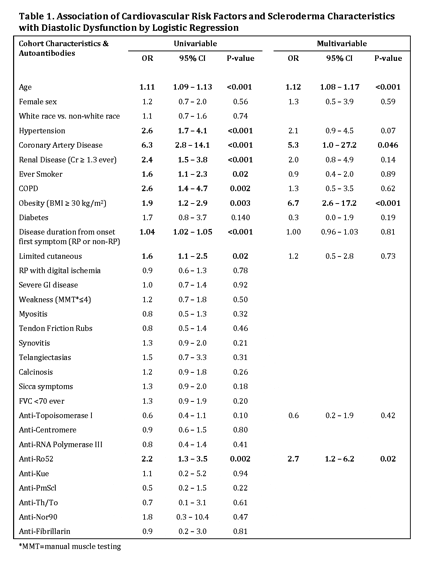Session Information
Session Type: ACR Poster Session A
Session Time: 9:00AM-11:00AM
Results: The prevalence of DD was 18.8%. Mean age at time of echocardiogram was 67.4 years (STD 9.7). Traditional DD risk factors including age, hypertension, coronary artery disease (CAD), renal disease, ever smoker, COPD, and obesity (>= 30kg/m2) were significantly associated with DD on univariable analyses (Table 1). Disease duration, limited cutaneous disease, and presence of anti-Ro52 autoantibody were significantly associated with DD on univariable analysis (Table 1). Only age, CAD, obesity, and a positive anti-Ro52 autoantibody were associated with DD on multivariable model (Table 1). An increase in age-adjusted all-cause mortality was seen in subjects with DD compared to those with normal diastolic function (p<0.0001) (Figure 1).
Conclusion: Patients not only with traditional cardiac risk factors but also with a positive anti-Ro52 autoantibody are at higher risk for DD. Given the poor survival associated with DD in this population, aggressive control of modifiable risk factors as well as further investigation into treatments is warranted.
To cite this abstract in AMA style:
Hinze AM, Hummers LK, Wigley FM, Mukherjee M, Shah AA. Diastolic Dysfunction in Scleroderma: An Investigation into Associated Risk Factors and Impact on Survival [abstract]. Arthritis Rheumatol. 2018; 70 (suppl 9). https://acrabstracts.org/abstract/diastolic-dysfunction-in-scleroderma-an-investigation-into-associated-risk-factors-and-impact-on-survival/. Accessed .« Back to 2018 ACR/ARHP Annual Meeting
ACR Meeting Abstracts - https://acrabstracts.org/abstract/diastolic-dysfunction-in-scleroderma-an-investigation-into-associated-risk-factors-and-impact-on-survival/


